View in other NatureServe Network Field Guides
NatureServe
Montana
Utah
Wyoming
Idaho
Wisconsin
British Columbia
South Carolina
Yukon
California
New York
A Diatom - Navicula goersii
General Description
Morphological Category – Symmetric biraphid
Frustules flat, almost always coming to rest in valve view due to shallow mantles (1.5-2.0 µm deep).
Valves broadly lanceolate with acutely rounded ends in all but the smallest specimens.
Axial area narrow;
central area broad, rectangular, reaches nearly to the valve margins. A single, shortened stria present on each side of the central area. External raphe fissures straight and threadlike.
Raphe. Proximal raphe ends slightly inflated and relatively distant from one another. Terminal raphe fissures bent diagonally towards the valve margin, characteristically in close contact with a single areola at each apex, making the raphe fissures appear as hook-like terminations.
Striae broad, lineate, radiate and slightly curved about the central area; parallel or slightly convergent towards the apices. Striae extend onto the valve mantle.
Size RangeLength 8-14 µm.
Width 3-4 µm.
Striae in 10 µm 14-18.
Type Locality: Davis Creek near Busby, Big Horn County, Montana, USA
Useful Link:
Diatom Glossary [Diatoms of North America website]
Diagnostic Characteristics
Species of Hippodonta have more strongly silicified frustules, broader profiles in girdle view, and simpler external raphe systems that lack the hooked or strongly deflected terminal fissures characteristic of Navicula species.
Navicula goersii is distinguished from
N. perminuta by its subrostrate rather than obtusely rounded ends. It differs from
N. exilis by its smaller size, coarser striation, and rectangular shape of the central area. It differs from
N. veneta by its smaller size, subrostrate ends, and distinctly transverse central area.
Range Comments
Distribution is apparently restricted to North America. Common and widely distributed across the Northwestern Great Plains; also recorded from North Dakota, South Dakota, Wyoming, Oregon and California; a few isolated records from the eastern United States.
Observations in Montana Natural Heritage Program Database
Number of Observations: 113
(Click on the following maps and charts to see full sized version)
Map Help and Descriptions
Relative Density
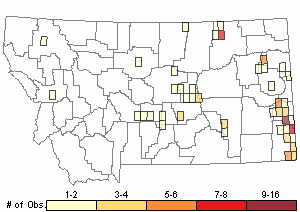
Recency
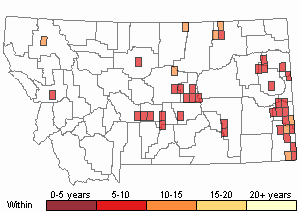
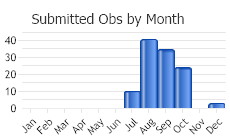
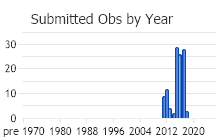
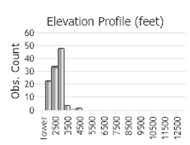 (Observations spanning multiple months or years are excluded from time charts)
(Observations spanning multiple months or years are excluded from time charts)
Habitat
Found in prairie streams and rivers.
Ecology
Warm, alkaline waters with moderate to high nutrients and conductivity, which are typical of the sagebrush and grassland prairies of the western United States. Common diatom associates of N. goersii are
Diploneis puella,
Navicula caterva,
Biremis circumtexta,
Navicula canalis ,
Fallacia tenera,
Nitzschia reversa, and
Pleurosigma delicatulum.
WATER CHEMISTRYAbundance-weighted mean values for selected variables: C = 2039 µS/cm; pH = 8.4; T = 18.4 °C; total nitrogen = 1.810 mg/L; total phosphorus = 0.137 mg/L
Reproductive Characteristics
Diatoms typically reproduce by cell division (mitosis) and occasionally by meiosis—sexual reproduction in which female and male gametes combine to form a specialized zygote called an auxospore. Repeated divisions result in cells of a population becoming progressively smaller and smaller. When cells reach a critically small size, sexual reproduction is initiated, resulting in an auxospore and initial cells that are the largest attainable for the species, after which cell division and size reduction resume (Amato 2010).
Stewardship Responsibility
Threats or Limiting Factors
Apparently secure in the Northwestern Great Plains.
References
- Literature Cited AboveLegend:
 View Online Publication
View Online Publication Amato, A. 2010. Diatom reproductive biology: living in a crystal cage. The International Journal of Plant Reproductive Biology 2(1): 1-10.
Amato, A. 2010. Diatom reproductive biology: living in a crystal cage. The International Journal of Plant Reproductive Biology 2(1): 1-10.
- Additional ReferencesLegend:
 View Online Publication
View Online Publication
Do you know of a citation we're missing? Bahls, L.L. 1983. A new diatom from southeastern Montana. Proceedings of the Montana Academy of Sciences 42:1-6.
Bahls, L.L. 1983. A new diatom from southeastern Montana. Proceedings of the Montana Academy of Sciences 42:1-6. Bahls, Loren. 2021. Diatoms of Montana and western North America: Catalog and atlas of species in the Montana diatom collection Volume 1. The Academy of Natural Sciences of Philadelphia Special Publication 24. 508pp.
Bahls, Loren. 2021. Diatoms of Montana and western North America: Catalog and atlas of species in the Montana diatom collection Volume 1. The Academy of Natural Sciences of Philadelphia Special Publication 24. 508pp.
- Web Search Engines for Articles on "A Diatom"





